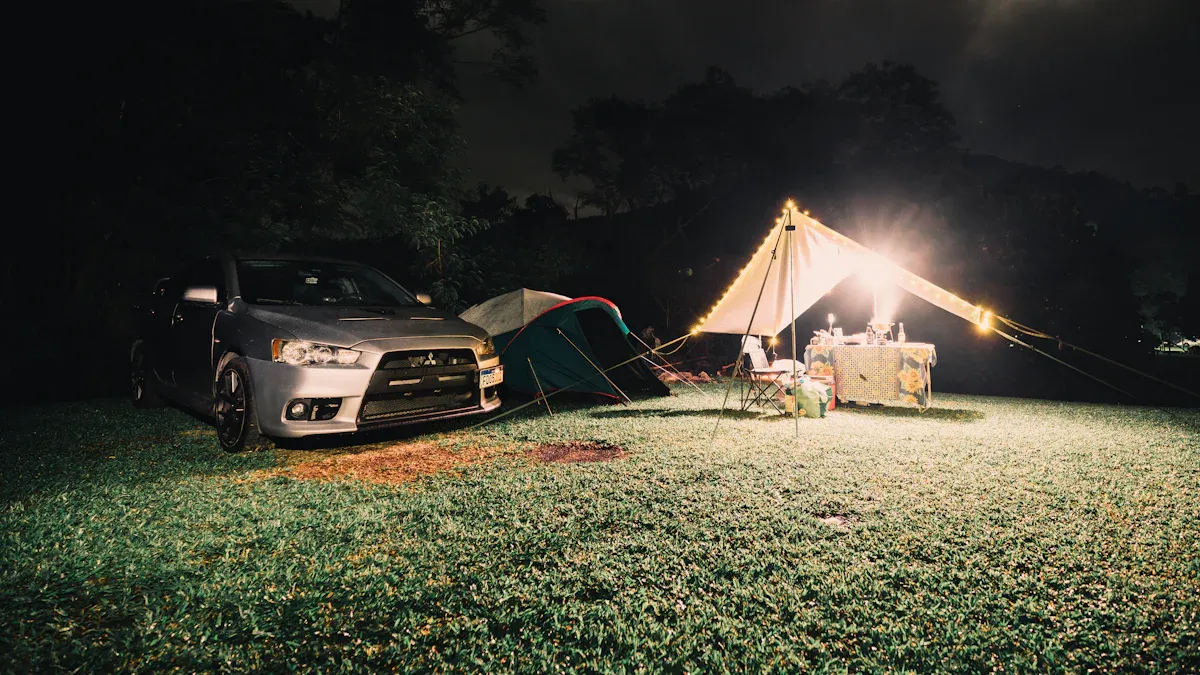
Outdoor hospitality resorts depend on commercial-grade camping lights to enhance guest safety and create inviting environments. These lighting solutions ensure pathways remain visible after sunset, helping guests navigate the property with confidence. High-quality hospitality lighting also supports efficient resort operations by providing reliable illumination in all weather conditions. Resort owners recognize that investing in durable lighting systems increases guest satisfaction and helps maintain a strong reputation.
Key Takeaways
- Choose durable, weather-resistant camping lights to ensure long-lasting performance and reduce maintenance costs in outdoor resort settings.
- Invest in energy-efficient LED and solar-powered lighting to lower utility bills and support eco-friendly resort operations.
- Use a variety of lighting types like string lights, floodlights, pathway lights, and portable lanterns to enhance guest safety, comfort, and ambiance.
- Plan lighting based on resort layout, guest needs, and activities to create inviting spaces that improve guest satisfaction and safety.
- Balance quality and budget by considering total costs, energy savings, and maintenance to make smart lighting investments that boost your resort’s reputation.
Key Features of Commercial-Grade Hospitality Lighting
Durability and Build Quality
Commercial-grade hospitality lighting must withstand the demands of continuous use in outdoor resort environments. Manufacturers design these lighting products with robust materials and advanced engineering to ensure long-term reliability. Rigorous performance tests validate their durability and build quality:
- Lumen Maintenance: Engineers measure how well an LED maintains its light output over thousands of hours, which indicates long-term durability.
- Testing Duration: Extended testing, often between 6,000 and 10,000 hours, simulates real-world lifespan and performance.
- Extrapolation of Lumen Maintenance: Specialists predict product lifespan by estimating when light output falls below industry thresholds, such as L70.
- Test Conditions: Tests occur at multiple temperatures and drive currents to ensure consistent performance across various environments.
Tip: Resorts that invest in lighting products with proven durability reduce maintenance costs and minimize disruptions to guest experiences.
Weather Resistance
Outdoor hospitality lighting faces constant exposure to the elements. Manufacturers subject these products to a series of environmental and durability tests to guarantee performance in challenging conditions. Key assessments include:
- Ingress Protection (IP) testing, which evaluates resistance to dust and water and provides a standardized protection rating.
- Environmental and durability testing, which simulates vibration, humidity, temperature cycling, and accelerated aging.
- Accelerated stress testing, which replicates real-life stress conditions to assess product life and reliability.
Lighting that passes these tests can operate reliably through rain, wind, and temperature fluctuations, making it ideal for outdoor hospitality settings.
Brightness and Light Output
Brightness and light output play a crucial role in creating safe, comfortable, and visually appealing resort environments. Technical performance metrics help resorts select the right lighting for each application. The following table summarizes key benchmarks:
| Metric | Definition / Unit | Role in Hospitality Lighting Application |
|---|---|---|
| Luminance | Visible light per unit area (cd/m² or nits) | Ensures displays and areas remain visible and comfortable under varying ambient light conditions. |
| Luminous Intensity | Light strength in a specific direction (candelas) | Supports directional lighting, such as spotlights or focused LEDs, to highlight features or create mood. |
| Luminous Flux | Total light output (lumens) | Evaluates overall brightness capacity for large spaces or pathways. |
| Illuminance | Light falling onto a surface (lux) | Assesses ambient lighting and calibrates brightness for visibility and energy efficiency. |
| Peak Luminance | Maximum luminance under specified conditions | Verifies lighting meets brightness requirements for hospitality applications. |
| Uniformity Mapping | Luminance variation across a surface | Ensures consistent brightness, which is important for guest comfort and safety. |
| Black-level Luminance | Minimum luminance for contrast ratio | Affects image clarity and visual quality in hospitality displays. |
| Ambient Light Compensation | Adjustments based on surrounding lux levels | Enables dynamic adaptation to changing light, enhancing guest experience and energy savings. |
LED bulbs used in hospitality lighting last between 3 to 25 times longer than traditional bulbs and consume 25% to 80% less energy. This significant improvement in longevity and efficiency supports both operational reliability and sustainability goals for resorts.
The commercial lighting market, which includes hospitality applications, was valued at approximately $10.01 billion in 2023 and is projected to grow to $14.18 billion by 2029. This growth, with a compound annual growth rate of 5.9%, reflects the increasing adoption of innovative, energy-efficient lighting solutions in the hospitality sector.
Energy Efficiency
Energy efficiency stands as a top priority for outdoor hospitality resorts. Operators seek lighting solutions that reduce energy consumption while maintaining high performance. Modern hospitality lighting often features advanced LED technology, which uses significantly less electricity than traditional incandescent or halogen bulbs. LEDs also produce less heat, which helps lower cooling costs in warmer climates.
On-site surveys from major California utilities, including PG&E, SCE, and SDG&E, have measured the efficiency of commercial lighting systems. These surveys found that efficient lighting technologies, such as T8 fluorescent fixtures and compact fluorescent lamps (CFLs), reached saturation levels above 55% and 59% respectively in commercial buildings. High-intensity discharge (HID) lighting also accounted for about 42% of installations. Lighting represents nearly 39% of total commercial energy consumption, which equaled approximately 31,000 GWh in 2000 across these utilities. Energy use intensity (EUI), measured in kilowatt-hours per square foot, helps resorts estimate their lighting-related energy costs and identify opportunities for improvement.
Resorts that invest in energy-efficient lighting benefit from lower utility bills and reduced environmental impact. Many commercial-grade camping lights now offer features such as dimming, motion sensors, and solar charging. These options further optimize energy use and support sustainability goals.
Post time: Jun-20-2025
 fannie@nbtorch.com
fannie@nbtorch.com +0086-0574-28909873
+0086-0574-28909873





